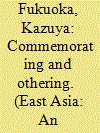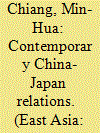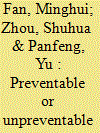|
|
|
Sort Order |
|
|
|
Items / Page
|
|
|
|
|
|
|
| Srl | Item |
| 1 |
ID:
171152


|
|
|
|
|
| Summary/Abstract |
The Yasukuni Shrine in Tokyo, once the symbolic center of national commemoration of war dead in pre-War years, is now regarded as one of the critical conservative symbols of Japan’s imperial past. While the Yasukuni study is expanding, not much has been explored on the nature of public reactions to the controversy. This study explores Prime Minister Abe Shinzo’s Yasukuni pilgrimage in 2013 and delves into Japanese public opinion on and around it. Overall, the Japanese public is relatively composed and prefers cautious approach; yet, at the same time, more people now support the official Yasukuni visits in general. This study also reveals discernible, yet nuanced, disagreements among PM Abe’s Yasukuni policies, the public perceptions of them, and the narratives of major newspaper editorials on this issue. The coverage of public opinion polls by the major national newspapers uncovers the public opinion on (1) the official Yasukuni visit, (2) the idea of building an alternative non-religious national memorial, and (3) the Japanese public’s decreasing sense of affinity toward China and South Korea (and their implications on understanding the Yasukuni issue and the sense of nation). The study will also examine the newspaper narratives on the controversy, which should help exemplify the overall public mood over the years.
|
|
|
|
|
|
|
|
|
|
|
|
|
|
|
|
| 2 |
ID:
171148


|
|
|
|
|
| Summary/Abstract |
This article presents the importance of political factors in the development of China-Japan economic relations over the last four decades. The China-US reconciliation and the rise of the pro-China Japanese Prime Minister Tanaka Kakuei (1972–1974) led to the normalization of China-Japan relations in 1972. The bilateral political rapport was further consolidated in the face of the common threat in the Soviet Union. With the strengthening political relations, the bilateral economic exchanges were gradually developed. Nonetheless, following the collapse of the Soviet Union, mounting Sino-US tension, China’s growing assertiveness, and rising nationalism in both China and Japan, the Sino-Japanese bilateral political relations have been deteriorating. The escalating political tensions have impacted bilateral economic relations, including declining Japanese investment in China, weakening bilateral trade, and decreasing Japanese visitors to China. Despite improving bilateral political relations in recent years, it is uncertain how long these friendly gestures by the leaders of the two countries may last given several unsettled territorial and historical issues. The growing tension between the United States and China further adds uncertainty to China-Japan relations in the future. Without strong political relations, weakening economic ties cannot be easily restored.
|
|
|
|
|
|
|
|
|
|
|
|
|
|
|
|
| 3 |
ID:
171154


|
|
|
|
|
| Summary/Abstract |
Investigate the relationship between Islamic leadership, innovation, competitive advantages, and performance of small- and medium-sized enterprises (SMEs) in Indonesia, especially investigate the mediation effect of innovation and competitive advantage in the relationship between Islam leadership and the performance of SMEs. The focus of this study is the SME (small and medium entrepreneurs) of typical food products of Riau domiciled in Riau. The population in this study was all the SMEs, and the sample size is 160 respondents. The method used to analyze the data in this study is WarpPLS [1], for inner model (hyphothesis testing for structural model) and outer model (measurement model for unobservable variables). Sobel test (under WarpPLS model) was used to test whether a variable is a variable mediating the relationship between endogenous variables and exogenous variables. The conclusions of this research are the following: (1) Islamic leadership does not have a direct effect on the performance of SMEs, (2) Islamic leadership has an indirect effect on the performance of SMEs, with competitive advantages and innovation as mediation variables. Originality for this paper shows the following: (1) mediation effect (using Sobel test) of competitive advantage and innovation in the relationship between Islam leadership and the performance of SMEs and (2) location of study (no previous research for this relationship): SME in Riau.
|
|
|
|
|
|
|
|
|
|
|
|
|
|
|
|
| 4 |
ID:
171149


|
|
|
|
|
| Summary/Abstract |
China’s polluted air has seriously affected the health of the Chinese population. This paper uses attribution theory to investigate how Chinese newspapers and non-Chinese newspapers presented smog in China and attributed causes and responsibilities. Built on previous studies, this study adopted covariation model within attribution theory and painted an interesting picture of smog coverage by Chinese and non-Chinese newspapers because of the apparent differences in perspectives. The criteria further provided folder for elaboration on explaining why the different coverages attributed causes as they did. Implications are discussed.
|
|
|
|
|
|
|
|
|
|
|
|
|
|
|
|
| 5 |
ID:
171150


|
|
|
|
|
| Summary/Abstract |
This paper addresses the Chinese policy community’s interpretations of identities, which potentially shape the soft power policies of China. It couples soft power to identity through a discourse analysis of the language used by the Chinese state in relation to soft power. It builds on a number of earlier theorizations that associate soft power with identity as a discursive phenomenon. The results highlight the use of strategic disrespect in China’s soft power discourse. In the context of global cultural competition, and in particular the South-South cooperation framework, it is argued that the practitioners of the Chinese discourse present China’s ‘Self’ as a soft power and the Western ‘Other’ as a hard power.
|
|
|
|
|
|
|
|
|
|
|
|
|
|
|
|
| 6 |
ID:
171151


|
|
|
|
|
| Summary/Abstract |
After Asian financial crisis, the Japanese government quickly adjusted its foreign economic policy and, unlike their traditional image of inaction, actively carried out and led the crisis rescue work through separate policies. The introduction and implementation of the “New Miyazawa Initiative” represented that the focus of the Japanese government has shifted to the preparation for and construction of the regional local currency bond market. This was backed by the strategic consideration to restart yen internationalization (or yen re-internationalization). It reflects the Japanese government’s reflection and adjustment on the path selection of promoting the internationalization of yen in the early stage. Relying on such change, The Japanese government intended to foster regional yen bond market to build yen backflow mechanism in East Asia and to realize the long-term objective of yen internationalization through “regionalization.” On the twentieth anniversary of Asian financial crisis, this paper re-examines the change to yen internationalization strategy, which is of practical significance for other cases’ attempt to internationalize local currencies as RMB internationalization at present. With reference to the strategic change in yen Re-internationalization, RMB internationalization shall shift the focus from “trade settlement” in the past to “capital outflow” through fostering the regional RMB bond market, expand RMB backflow mechanism. China shall focus on Asian Infrastructure Investment Bank (AIIB) and other new regional financial cooperation platforms to promote RMB regionalization, thus finally realizing the strategic objective of RMB internationalization. Nevertheless, this path selection is inseparable from China’s positive attitude toward financial and capital liberalization.
|
|
|
|
|
|
|
|
|
|
|
|
|
|
|
|
|
|
|
|
|